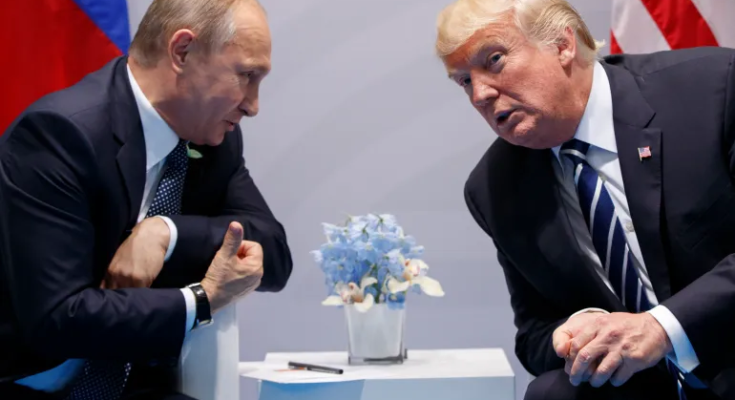March 8, 2025 – Seoul, South Korea
By Ussnapnews
By Al Jazeera Staff
United States President Donald Trump has signaled a tougher stance toward Russia, threatening to impose tariffs and sanctions as the Kremlin intensifies its military campaign against Ukraine. The announcement comes amid growing criticism of Trump’s perceived leniency toward Moscow and his strained relationship with Ukrainian leadership.
In a post on his Truth Social platform on Friday, Trump refrained from directly denouncing Russia’s ongoing invasion of Ukraine, which began in February 2022 and has been widely condemned as a violation of international law under the UN Charter. Instead, he pointed to Russia’s recent wave of attacks, which coincided with a U.S. decision to pause military intelligence sharing with Ukraine.
“Citing Russia’s relentless ‘pounding’ of Ukraine on the battlefield, I’m seriously considering major Banking Sanctions, Sanctions, and Tariffs on Russia until a Ceasefire and a FINAL PEACE AGREEMENT are secured,” Trump wrote. “To Russia and Ukraine: Sit down at the table now, before it’s too late. Thank you!!!”
Trump has consistently positioned himself as a potential “peacemaker” in the conflict, expressing a desire to broker an agreement between the two nations. However, his recent rhetoric has leaned heavily against Ukrainian President Volodymyr Zelenskyy while appearing more accommodating toward Russian President Vladimir Putin.
During a Friday press conference at the White House, Trump remarked that negotiating with Russia was proving “easier” than dealing with Ukraine. “Ukraine doesn’t hold the stronger hand here, and honestly, I’m finding them tougher to work with,” he said.
A Rocky Road with Ukraine
Tensions between Trump and Zelenskyy have flared since Trump’s second term began in January 2025. Within his Republican Party, skepticism about sustained U.S. support for Ukraine has grown, echoing Trump’s own reservations. His first term saw him impeached over allegations of pressuring Ukraine to dig up dirt on political opponents by threatening to withhold military aid—a history that some believe colors his current stance.
Recently, Trump has sharpened his criticism of Zelenskyy, accusing him of obstructing peace efforts. He has also suggested that Ukraine is unlikely to reclaim its pre-2014 borders, a nod to Russia’s annexation of Crimea and control over other territories. Additionally, Trump has dismissed Ukraine’s aspirations to join NATO, at times echoing Moscow’s narrative that the alliance’s expansion provoked the war.
On February 12, Trump touted a “lengthy and highly productive” call with Putin, announcing that peace talks between the U.S. and Russia would commence in Saudi Arabia. The move alarmed European allies and Ukraine, which feared exclusion from the process. A week later, on February 19, Trump labeled Zelenskyy a “dictator” for suspending elections under martial law—a measure Ukraine enacted due to the invasion.
Further straining ties, Trump has pushed for the U.S. to gain control of Ukraine’s valuable rare earth minerals, critical for technology manufacturing. When Zelenskyy resisted without firm security guarantees, a February 28 White House meeting erupted into a heated exchange. Trump scolded Zelenskyy for ingratitude, warning, “Make a deal, or we’re done,” while praising Putin’s resilience.
Soon after, Trump suspended U.S. aid to Ukraine and, on Wednesday, halted the sharing of military intelligence vital to Kyiv’s defense—a move that preceded Russia’s latest missile barrage on Ukrainian energy infrastructure.
Russia Exploits the Gap
In the pre-dawn hours of Friday, Russia unleashed a salvo of missiles targeting Ukrainian power facilities, capitalizing on Kyiv’s weakened defenses. Ukrainian officials reported success in downing Russian drones but struggled to intercept the missiles, underscoring the impact of the U.S. intelligence cutoff.
Addressing the attack from the Oval Office, Trump tied his sanctions threat to Russia’s aggression. “They’re hammering Ukraine right now,” he said. “I issued a strong statement: ‘You can’t do this.’ We’re trying to assist, but Ukraine needs to step up.”
When pressed on whether the intelligence suspension enabled Russia’s assault, Trump brushed off the notion, calling it a predictable escalation. “Putin’s hitting harder to push for a resolution,” he said. “I think both sides want this over, but Ukraine’s taking a beating, and I don’t understand their hesitation.”
Asked if the U.S. should bolster Ukraine’s defenses, Trump insisted Kyiv must prove its willingness to negotiate. “If they don’t want peace, we’re out,” he reiterated.
Efforts to Ease Tensions
Following the White House clash, Ukrainian officials have sought to repair relations with the U.S. ahead of next week’s Saudi Arabia talks. On Tuesday, Zelenskyy sent Trump a letter affirming Ukraine’s commitment to peace and readiness to collaborate under his leadership. “No one desires peace more than Ukrainians,” he wrote on social media.
Trump read excerpts of the letter to Congress, lamenting the “hundreds of billions” spent on Ukraine with “nothing in return.” “Are we going to keep this up for five more years?” he asked lawmakers.
Friday’s sanctions warning marks Trump’s strongest move against Russia since taking office, a shift from his predecessor Joe Biden, who imposed numerous sanctions on Moscow, including energy sector restrictions in late 2024. U.S.-Russia trade has plummeted from $36 billion in 2021 to $3.5 billion in 2024, per government data.
Al Jazeera’s Alan Fisher noted that Trump’s pivot might reflect pressure to counter perceptions of pro-Russia bias. “Many felt he was leaning too hard on Ukraine without holding Russia accountable,” Fisher said. “Biden led globally on sanctions; Trump hasn’t added any until now.”
Whether Trump will act on his threat remains uncertain, especially with a potential Putin meeting looming. For now, his balancing act between Russia and Ukraine continues to shape an unpredictable path forward.



